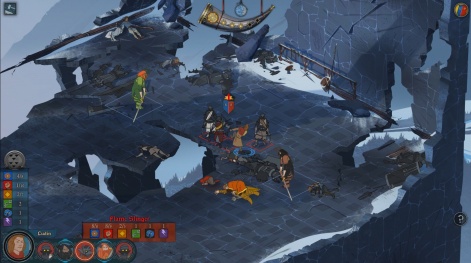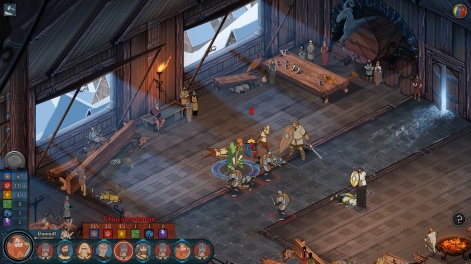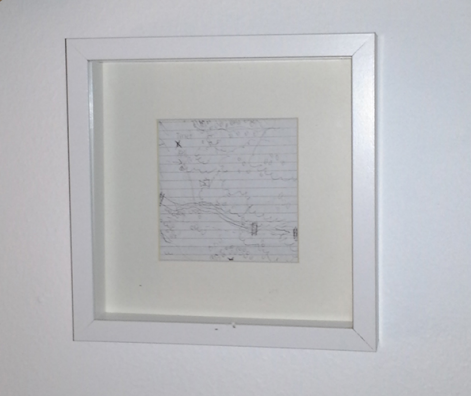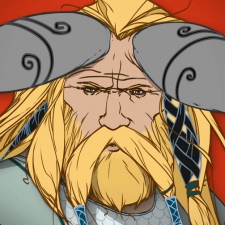When it comes to player choice, you'd be hard pressed to find a triple-A video game studio more committed than BioWare.
Creating complex characters and meaningful choices is BioWare's thing, and on mobile there aren't many games with a similar narrative ambition, but of those that do, The Banner Saga is one of the most acclaimed.
But it's no accident that The Banner Saga shares that design ethos. After all, Stoic, which was formed in 2012, is the result of three ex-BioWare employees forming a party - but instead of a Warrior, Rogue and a Mage, this party is comprised of a writer, a programmer and an artist. Formidable indeed.
Gather your party and venture forth
Alex Thomas, John Watson and Arnie Jorgensen worked together for five years at BioWare on Star Wars the Old Republic when they decided to create their own studio. The trio were enticed by the rise of good iOS games, the success of the teams behind them and, mostly, the creative freedom going independent offered. Stoic was born with Thomas as writer, Watson as programmer and Jorgensen as artist.
Jorgensen, a former penciler in comics, felt like it was a return to his roots. "I'd sit in a small studio with my inker and draw stuff that didn't have to pass through a battery of gatekeepers to see the light of day," he begins.
"Early on in my career I pretty much stunk, but with every book I got a little better, it was a great incubator for my skills to be honed.
"In games I went from working at Ion Storm and Retro Studios to head production designer for Star Wars Galaxies and then lead concept artist on Star Wars the Old Republic. Both had artists that I managed and people above me to please.
"Getting back into a small studio environment has gone a long way to making me feel alive creatively again."

Inspired by games like Super Brothers and Sworcery, the team saw the value in developing with iOS in sight, so although The Banner Saga made its debut on PC, the iPad was always the target platform.
"We quickly learned that the game we'd envisioned was a little too unwieldy for the first iPad and so we redirected our efforts in the direction of PC and Mac," remembers Jorgensen.
"The first few months of development we were playing the game on the iPad, though, and all through the process kept the iPad's usability in mind when designing both the UI and retina resolution size art."
Level up
When Stoic did finally convert the game to a more advanced device, it was only a case of Watson making some subtle - but not at all simple - changes, says Jorgensen.
"There was a ton of changes that still needed to be made from the size of clickables to the footprint of texture memory and sound, etc. John worked really, really hard to make it all happen and I'm glad he's on a vacation now."
The only thing the game lost in the transition from PC was a slight decrease of the viewable area on the combat boards, and there aren't as many parallaxing textures on screen. Jorgensen says that, for the most part, the game actually benefited from the new device.
The Banner Saga is an experience where the the game systems are really just a vehicle for a tale we want to tell."Arnie Jorgensen
"John was able to add in swiping to move around the screen during conversation and pinch-zoom features throughout," he points out.
"He added in camera panning and a re-written renderer optimised the load times and frame rate and even added more character animations. The list goes on, to the point that we're going to work to retrofit these additions into the PC and Mac version for players to enjoy. I, and many others, now prefer the mobile experience of The Banner Saga".
The switch in platforms isn't the only change the game has seen, either. Originally the control system in combat was almost identical to Final Fantasy Tactics. Jorgensen was worried that innovation in the game's UI could lead to confusion - he shared a great analogy about cars with indicators where the radio controls should be and accelerators in the gear box.

The team wanted players to feel comfortable as soon as they begin, much like console players can seamlessly flip between first-person shooters ever since Call of Duty: Modern Warfare created the modern blueprint for console FPS controls.
It didn't work as anticipated, however.
"The very first time we saw people play it en mass at Fantastic Arcade here in Austin we were dismayed," Jorgensen remembers. "No one knew how to interact with the game at all. I kept walking over and saying 'okay, press this button, now this one and then this one, now you can pick an ability and then click this then this and now you can end your turn...'It was a game in and of itself, like a bad puzzler.
"Anyway, we left Fantastic Arcade and rebuilt the entire UI from the ground up into the design now seen in the game, which is original to The Banner Saga as far as I know. The amazing community that sprang up around the combat demo we first put out, The Banner Saga: Factions, was a huge boon as well to the design and helped us find even slight errors in the controls."
This is your story
It wasn't just controls the game had to nail, though. Like most of BioWare's output, The Banner Saga was built with the plot in mind. In fact, rather than taking the route many games do and bending a narrative to fit the game's scenarios, The Banner Saga began as a story.
"Alex Thomas had this plot idea he'd been nursing since he was like 12 years-old," says Jorgensen. "When we first started talking about it he already had the idea to blend game styles like Oregon Trail, King of Dragon Pass and Shining Force into one story-based game. The plot was a somewhat generic medieval fantasy arc that we quickly moved away from into a Viking-themed saga.
"I grew up sailing in the North East and hearing family stories about Vikings, so I've always had a fascination with them and their art. Over many meetings we molded the plot into something that could roughly fit into 40 or so hours of gameplay. The Banner Saga is an experience where the the game systems are really just a vehicle for a tale we want to tell."

This tale is weaved through a spider's web of a branching narrative, crafted completely by Alex Thomas, with Drew McGee - another ex-BioWare staff member - handling sidequests.
"I can't speak to how Alex hooked the story from Inklewriter into the game as it's a system John wrote that I'm not familiar with, and I can't speak to how Alex's brain wrote it in the first place as that's a brain that can work on a story level far above my own," says Jorgensen.
This was a game where we all bit off not more than we could chew, but certainly as much as we could chewARNIE JORGENSEN
"I can't have Alex speak to it as Alex has taken a step away from The Banner Saga. This was a game where we all bit off not more than we could chew, but certainly as much as we could chew.
"Since the launch Alex has started another smaller game that takes a little less chewing and I know it will be really great. John and I are now psyched to be working with Drew McGee as lead writer for The Banner Saga 2. He's been with us from the start and been helping with the story and lore all along so he knows his stuff."
That lore is still being built upon, with the story and lore being iterated upon in a collaborative process.
"Some of the best times working on this game were the days and hours Alex and I took just adding idea to idea," says Jorgensen.
"The whole saga felt, at times, to be inspired by something beyond us, but I feel that's simply what happens when you work with someone back and forth in a truly cooperative way. Whatever it is comes out better than twice as good as you thought it could and you're surprised you had a part in it."
War in colour
Jorgensen's main input was outside of the story, though, in the game's striking, Disney-like art style.
"Ever since I was a kid I've had this fascination with Eyvind Earle's art in the Sleeping Beauty film," says Jorgensen. "I felt this basic art approach would work very well in juxtaposition with the sombre, serious tone of the story. It's a style that reminds us of the glory days of hand drawn animated movies, but upon closer inspection we can see it's actually a highly nuanced, mature style that doesn't belittle the emotion of the narrative, but rather works to support it.
"I ran some images of Eyvind Earle's work past John and Alex and they loved it. Next step was to take a piece from his and break it apart into the different layers and parallax it on the screen to see how it looked - it looked great. Next step was to do my own version of the art and see how that looked - it still looked great. Done and done.
"The character design is not taken from any movie in particular but just from how I naturally draw, maybe I'm riffing on stuff I learned from comics? But the simple line art with flood fill colors is supposed to harken back to an animated movie."
It wasn't just the characters Jorgensen designed, he also grew the intricate and detailed world map from a doodle on a piece of scrap paper to the believable world on-screen in the game. It began with just the basic flow of the story arc, with the important places the player visits and it just grew organically from there.

"I couldn't stop myself from going into more and more detail. Rivers, cities, towns, mountains, lakes, forests… I just wanted to make it all feel like a real place," Jorgensen recalls. "As I drew more and more Alex would come up with ideas for areas that I would then add in. Kind of like the story and lore grew organically so did the map, I think that's why the community has picked up on the feeling that everything seems to just belong where it is and it all makes sense.
"So, now we had this detailed art piece and then we said 'You know what would be great? If we could click on the different areas and read about them. Like, yeah, like not just the cities, but everywhere. Everything'.
The editing process
"This is where developers can get in trouble because things like this are so fun to do and you can't wait for players to see it, but you've also just given yourself a new huge system to support. Kind of like digging a little fish pond in your backyard that turns into a swimming pool that makes you sweat as you dig but then forget the sweat as you swim in the cool waters thereafter. So this map took on a life of it's own and we're glad it did."
The only problem with creating a larger and larger body of water is you risk it overflowing. It's not just a case of making a bigger pool, you need to know when to drain it.
Around four chapters were cut from the final build - these told the story of the northern Varl caravan. The team decided to cut these chapters as, although they added flavour, they didn't contribute anything to the main story and ended up being boring.
"Often times cutting makes a game or movie much tighter and we're really glad we cut those chapters," says Jorgensen.
"We also cut an idea that Alex held onto pretty tightly for a while.We originally had the design to run a quick cut-scene when a unit hit another unit in battle, so every time a unit would strike it would quick-cut to an animated close-up scene of the character swinging his axe, or whatever. After about two or three times I think the player would be clicking around the options to turn it off."
The biggest challenge wasn't in cutting material, though. Most of Stoic's worries stemmed from delivering after a hugely successful Kickstarter. The game's Kickstarter ended with a whopping $723,000 pledged, which was obviously a good thing, but the burden of responsibility weighed heavy on the team.
"Holy cow that's a scary amount of cash to offload to make the game better," says Jorgensen. "We put it all into the game by getting PowerHouse Animation to do more animations and cutscenes. Austin Wintory to compose a score. KPow audio to do the sound...etc. We still lived on our own savings but now both The Banner Saga: Factions and The Banner Saga were taking much longer to produce than we originally figured. It definitely got dicey near the end of development with both money and really long work days."
Because of the success Stoic had with the Kickstarter, the team never considered free-to-play. This gamble has seemed to pay off, with current sales exceeding expectations. The profits made from the game are being used to fund its sequel.
"We've made enough to ensure The Banner Saga 2 will get made and have actually been making it for some time now," Jorgensen says. "For the first time in a few years we're making a modest salary again, whew!"
The saga continues...






















